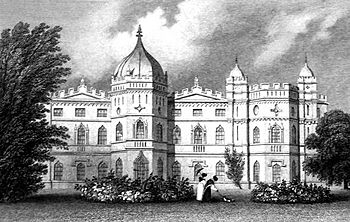Tong Castle facts for kids
Tong Castle was a very large country house in Shropshire, England. It was built in a style called Gothic Revival. The castle was located between the cities of Wolverhampton and Telford. It sat within a beautiful park designed by a famous landscape architect named Capability Brown. The house was built on the same spot where an older, medieval castle once stood.
Contents
What Was Tong Castle?
Tong Castle was a grand house that looked like a medieval castle. It was known for its unique design. Some people called it an "architectural mongrel" because it mixed different styles. However, others praised it as the "first real gothic building in Shropshire." The house had ogee domes, which are curved shapes. These domes looked Gothic but also had a touch of the English Renaissance style. The house was built in the Strawberry Hill Gothic style. This style was made popular by Horace Walpole.
The First Castle and Its History
The very first castle at Tong was built in the 12th century. This means it was built over 800 years ago! During the English Civil War, the castle was defended for King Charles I. Two brave men, William Careless and George Mainwaring, helped protect it. The original castle was torn down in 1765. This happened after George Durant bought the land from the Duke of Kingston. Durant then built the large house that is shown in old pictures.
Designing the New Tong Castle
George Durant bought the Tong estate in 1764. He hired Lancelot "Capability" Brown to help him. Brown was famous for designing beautiful landscapes. In 1765, Brown made plans to rebuild the castle and improve the land around it. This was Brown's first project in Shropshire.
Changes to the Landscape
Capability Brown made many changes to the park. He altered the water features near the castle. He created two new lakes called Church Pool (or North Pool) and the winding South Pool. The kitchen garden, where vegetables were grown, was moved further away from the house. It is also believed that Brown was responsible for adding an ice house. An ice house was a special building used to store ice all year round.
The Gothic Style of the House
The old Tudor Tong Castle was updated to look Gothic. Only the main part of the 16th-century red-brick castle was kept. Some stones from a nearby college were used in the new building.
The Strawberry Hill Gothic style was quite rare. Horace Walpole started building his Gothic house at Strawberry Hill in 1749. It was finished in 1776. Tong Castle was built in 1765, which was quite early for this style. This makes Tong Castle very important in architectural history.
The house had towers with crenellations, which are like the battlements on old castles. It also had pediments, which are triangular shapes above windows or doors. The windows were different from traditional Gothic windows. They had panes of glass instead of leaded designs. They were topped with ogee curves. The house also featured large bay windows. These windows had circular windows and cruciform (cross-shaped) designs on their upper levels.
Later Gothic styles in the 19th century were often darker and more serious. They had small, narrow windows called lancet windows. But the earlier Gothic style, like Tong Castle, had bigger windows. It also had a more joyful and lively design.
People Connected to Tong Castle
In 1756, a famous person named Maria Fitzherbert was born at Tong Castle. At that time, the Duke of Kingston still owned the castle. Maria Fitzherbert later married George IV, who was then the Prince of Wales. She had been widowed twice before marrying him. She died in 1837. Her marriage to George IV was never officially recognized. This was because she was Catholic. Also, George's father, King George III, had not given his permission for the marriage.
The End of Tong Castle
The Durant family owned Tong Castle until 1854. Then, the house was passed to the Earl of Bradford. The Earl did not want to live at Tong. Instead, he expanded his land in the area. He rented out the house, mostly to the Hartley family from Wolverhampton. They lived there from 1856 to 1909.
In 1911, a fire damaged the house. It was never fully repaired. Over time, it became more and more unstable. Finally, in 1954, it was torn down. Today, the site where Tong Castle once stood is part of the M54 motorway.
Even though the castle is gone, you can still see parts of Capability Brown's work at Tong. You can find the foundations of the castle. Church Pool is still there. You can also see groups of oak and beech trees that he planted. Tong Castle is a Grade II Listed site. This means it is recognized for its special architectural or historic importance. It was first listed on August 29, 1984.
Images for kids



